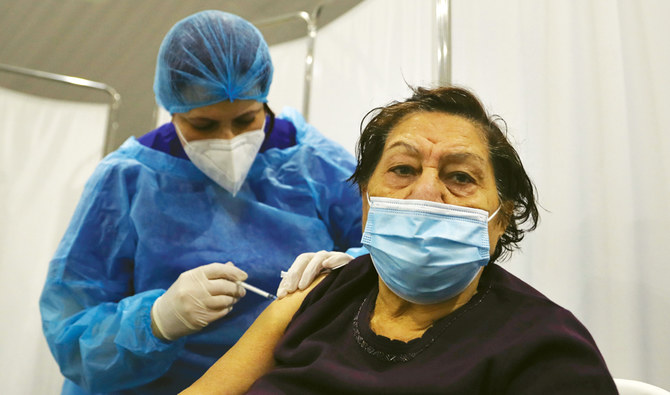BEIRUT: Human Rights Watch (HRW) has reported that refugees and migrant workers in Lebanon are at risk of being neglected in the coronavirus disease (COVID-19) national vaccination campaign, raising concerns for the welfare of Syrian and Palestinian refugees.
HRW warned that the “COVID-19 vaccination program risks leaving behind marginalized communities, including refugees and migrant workers who constitute one-third of the Lebanese population.”
Nadia Hardman, a refugee and migrant rights researcher at HRW, said: “With one in three people in Lebanon a refugee or migrant, a third of the population risks being left behind in the vaccination plan,” and urged the Lebanese authorities to “invest in targeted outreach to build trust with long-marginalized communities or the COVID-19 vaccination effort is doomed to fail.”
Lebanon commenced its vaccination process for all residents, regardless of nationality, on Jan. 28, with beneficiaries urged to register on the Ministry of Health’s platform.
The free Pfizer and AstraZeneca vaccines still cover the elderly, along with medical personnel and healthcare workers. Two weeks ago, private companies started offering their employees the Russian Sputnik vaccine free of charge.
On Tuesday, the Lebanese government received 90,000 doses of the Chinese Sinopharm vaccine as a donation from the Chinese authorities, with an additional 40,000 vaccines for the Lebanese Army.
Lebanon’s caretaker Health Minister Hamad Hasan said: “The vaccines are safe and the inoculation process raises the possibility to combat this pandemic that has harmed the economy of several countries, infected a lot of people and led to death.”
According to those involved with the vaccination process, a small number of people have registered on the official platform. Only 1,051,614 people of all nationalities residing in Lebanon — including 119,033 aged 75 and above — have registered.
According to unofficial estimates, the Lebanese population exceeds 4 million, with 865,531 Syrian refugees and around 200,000 Palestinian refugees. But the number of foreign workers has dropped. Some 9,780 work permits were given to foreign workers by the Lebanese General Security in 2020, an 83 percent decrease from the 57,957 given in 2019. This is due to the economic collapse and the struggle to pay foreign workers in dollars.
Former Lebanese Minister Hassan Mneimneh, chairman of the Lebanese Palestinian Dialogue Committee, told Arab News: “Since the launching of the vaccination process and the electronic platform, I have met with the Palestinian leadership and people concerned at the UN Relief and Works Agency for Palestine Refugees in the Near East (UNRWA) to look into encouraging Palestinian refugees to register for the vaccine.
“Some effort is exerted, however, there are many obstacles in the face of the refugees’ registration, such as the unavailability of the Internet. Moreover, some people have unjustified delusions about the vaccine, noting that the Lebanese centers specified for vaccination are not far from the Palestinian camps and can be reached without any additional cost.”
He noted that “Lebanon is receiving small numbers of vaccines, thus, the inoculation process is slow and includes until now only the elderly, which does not exceed 10,000 Palestinians.”
He added that “meetings are held with the Ministry of Health, aiming to urge people to register. The ministry informed us that within two days, an UNRWA platform — linked to the official platform — will open, facilitating the registration process.”
So far, just 690 Syrian refugees have received the vaccine from the 82,000 who have registered.
UN High Commissioner for Refugees (UNHCR) spokesman in Lebanon, Amro Al-Naim, told Arab News: “UNHCR’s teams on the ground are assisting refugees to register on the online platform, namely elderly and those with limited or no internet access. Support with transportation is also planned for refugees with no available means, to help them access the vaccination centers.”
He added: “Through our various social media platforms, call centers, and dedicated communication channels, UNHCR works with refugees to ensure that information on the vaccine is readily available to all, and to counter the risks of misinformation on the vaccine and COVID-19 in order to mitigate hesitancy and resistance towards vaccination”.
A worker with Syrian refugees said that the slow rollout of vaccines for migrants is partly due to a significant number of them being undocumented.
“They fear being deported from Lebanon if they register. They cannot leave the camps to vaccination centers. There is also the economic factor: Their priority is to provide food for their families and the cost of going to a vaccination center that is far from the camps is high.”
The UNHCR clarified that encouraging refugees to get the vaccine is not limited to Syrians as there are many refugees from other countries, such as Iraq.
Iraqi refugee Boulos Botros, 75, addressed other refugees on Twitter while getting vaccinated, encouraging them to get the vaccine. He said: “I encourage the elderly and young people to get vaccinated, in order to get rid of this deadly virus.”
But President of the Syrian Refugee Voice Committee in Lebanon Abu Ahmed Soubaiah said that “most Syrian refugees in Arsal camps, the largest concentration of camps in Lebanon, are not convinced and do not wish to receive the vaccine, as they do not trust the UNHCR that neglected them, and do not see a purpose in getting the vaccine, amid harsh living conditions that made them fail to keep sight of the purpose of life.”
















